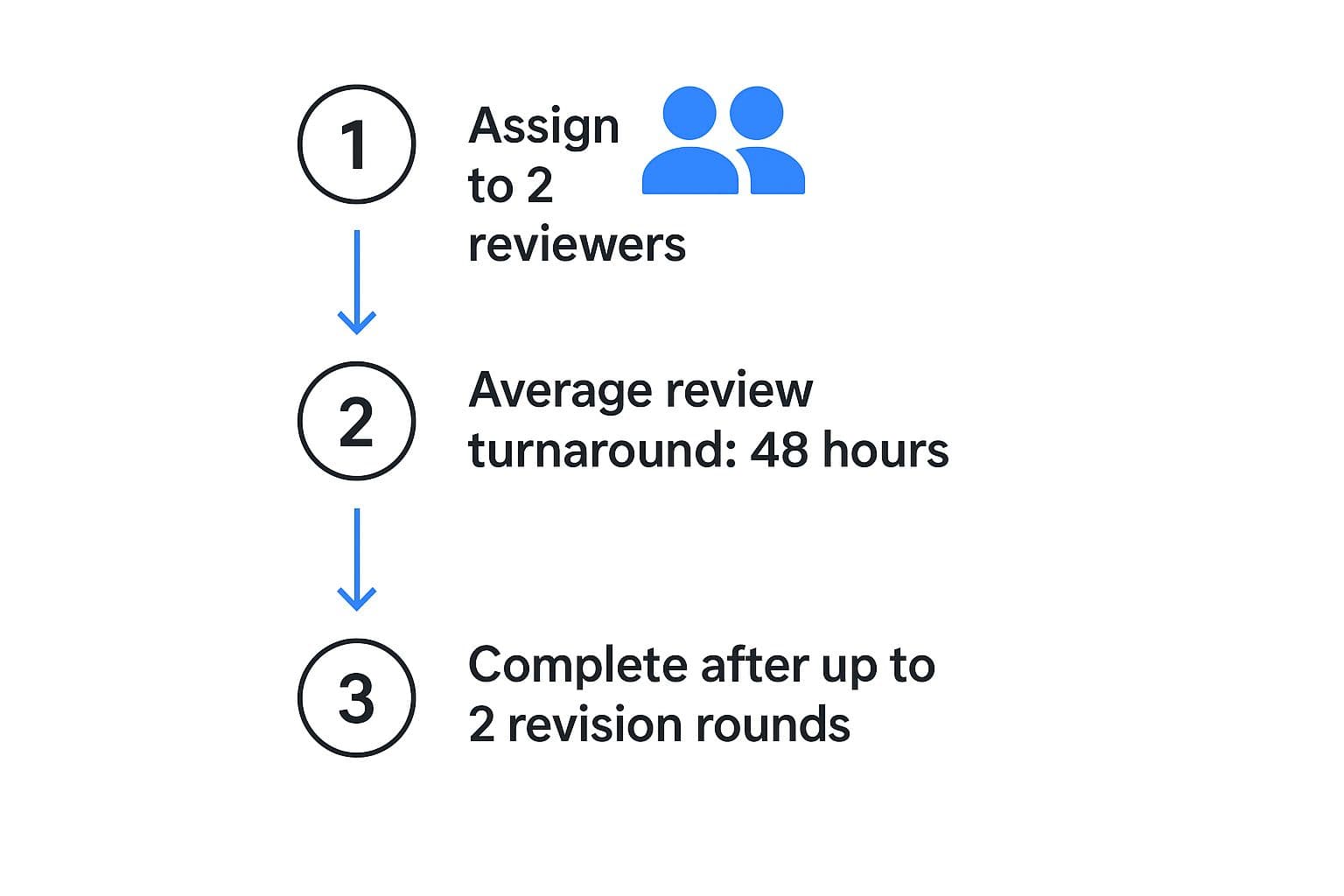Streamline Your Content Review Process for Better Results
Master the content review process to improve quality and efficiency. Learn tips to get your content right the first time and save time.

A solid content review process is pretty much your quality control system for everything you put out there—every blog post, email, and social media update. Think of it as a structured workflow that makes sure your content is accurate, on-brand, and free of embarrassing typos before it ever hits your audience. It's the safety net that protects your brand's hard-earned reputation.
Why a Flawless Review Process Matters
Let's be real, hitting 'publish' can be terrifying. A million questions race through your mind: Is there a typo? Does this even sound like us? Is the information 100% correct? A structured content review process isn't just about adding more steps; it's your essential shield against damaging your brand, losing trust, and wasting a ton of effort.
Skipping this step can have real, painful consequences. A simple typo might make you look a bit sloppy, but bigger issues like factual inaccuracies can completely torpedo your authority. You risk losing your readers' trust over small mistakes and completely eroding your credibility with poorly checked information.
The Real Cost of Inaccurate Content
The bar for content quality has never been higher. We're all drowning in information, so user trust is now directly tied to how reliable and accurate you are. The moment that trust starts to wobble, your audience is gone.
Just look at a giant like Wikipedia, one of the most-visited information hubs on the planet. Its whole setup is designed to share massive amounts of information.

Even with its massive reach, perceptions of declining reliability have had a huge impact. In the last three years alone, the platform has seen a jaw-dropping loss of over 1 billion monthly visits—that’s nearly a quarter of its total traffic. This drop is a stark reminder of what happens when content quality slips and proves why having tough review standards is non-negotiable. You can find more insights about digital user behavior and trust in recent reports.
From Chaos to Consistency
Without a defined process, content creation often just becomes chaos. You know the drill: a flurry of last-minute emails, conflicting feedback in a messy Slack channel, and total confusion over which Google Doc is the actual final version. This reactive scramble isn't just stressful; it's incredibly inefficient.
A strong content review process completely changes the game. It moves your team from putting out fires to following a streamlined system that guarantees quality and consistency, every single time. This isn't just about one article; it's the foundation that supports your entire content strategy.
A great process transforms every piece of content from a potential liability into a valuable asset. It builds a library of trustworthy, polished material that consistently strengthens your brand, engages your audience, and drives results.
Putting a formal review workflow in place gives you some serious advantages:
- Enhanced Quality: Catching errors before you publish builds trust and makes your brand look professional and buttoned-up.
- Brand Consistency: It ensures every piece of content, no matter where it lives, has the same tone, style, and message.
- Improved ROI: High-quality, relevant content just performs better. That means more traffic, higher conversion rates, and better results from your campaigns.
- Team Alignment: It gets everyone on the same page—writers, SEOs, legal, brand experts—which encourages collaboration and a sense of shared ownership.
Ultimately, spending time to build a solid content review process is an investment in your brand's future. It makes sure that every single word you publish is working for you, not against you.
Building Your Content Review Dream Team

A great process is just a document until you have the right people to bring it to life. Putting together your content review team isn’t just about filling seats—it’s about giving people clear ownership so every piece of content gets the attention it deserves. Think of it less like a rigid corporate structure and more like assembling a specialist crew.
I like to compare it to a pit crew for your content. Each person has a specific job, and they jump in at just the right moment. The goal? Get your content out on the track, performing at its absolute best. When you define these roles clearly, your entire content review process just works.
The Four Essential Reviewers
For most content, you can build a rock-solid review team around four key functions. Remember, these are roles, not necessarily job titles. On a smaller team, one person might easily wear a couple of these hats.
The Subject Matter Expert (SME): This is your truth-teller. Their only job is to check for factual accuracy. Are the stats right? Are the technical details correct? Is the advice sound? This person ensures the content is genuinely valuable and trustworthy.
The Brand Voice Guardian: This person is the soul of your brand. They’re making sure the content sounds like you. They check the tone, the style, and the personality. They’re constantly asking, "Does this feel like us? Does it reflect our values?"
The SEO Analyst: This is your performance specialist. They’re looking at the content through the lens of search engines and users. They'll hunt for keyword opportunities, check for search intent alignment, and find smart places for internal links. Their mission is to give the content its best shot at ranking and driving traffic.
The Final Proofreader: This is your last line of defense against embarrassing mistakes. They are the hawk-eyed reviewer who catches typos, grammatical slip-ups, broken links, and wonky formatting before it goes live. They deliver that final, polished, professional sheen.
A Quick Look at Key Roles
To make this crystal clear, here’s a simple breakdown of who does what. This table helps everyone understand their specific lane, which is the key to an efficient workflow.
| Role | Primary Focus | Key Responsibilities |
|---|---|---|
| Subject Matter Expert (SME) | Accuracy & Credibility | Verify technical details, data, and claims; ensure information is up-to-date and correct. |
| Brand Voice Guardian | Tone & Consistency | Check for alignment with brand personality, style guide, and voice; ensure a consistent reader experience. |
| SEO Analyst | Performance & Visibility | Optimize for target keywords, check search intent, add internal links, and craft meta descriptions. |
| Final Proofreader | Quality & Polish | Catch spelling/grammar errors, fix broken links, and correct formatting issues before publication. |
Having these distinct roles stops the "too many cooks in the kitchen" problem and ensures every critical aspect of the content is reviewed by an expert eye.
Let’s Walk Through a Real-World Example
So how does this all play out? Imagine your team just finished writing a technical blog post: "A Guide to Implementing Webhooks for SaaS Integrations." It's a chunky piece, full of code snippets and aimed squarely at developers.
First, it goes to the SME—let's say it's a senior engineer. They aren't looking for typos or worrying about the brand voice. They are meticulously combing through the code, checking the technical steps, and making sure the explanations are 100% accurate. Their feedback might be things like, "This endpoint is deprecated; use the V3 instead," or "You need to add a note about rate limiting here."
Once the engineer signs off on the technical side, the draft moves to the Brand Voice Guardian (maybe your content marketing manager). They'll read it through to make sure it’s not overly academic, softening the language to sound more helpful and conversational. Their comments might be, "Let's rephrase this to be less robotic," or "This intro feels a bit dry; can we open with an analogy?"
The order here is everything. The SME has to go first. There's no point in the brand guardian spending an hour polishing a paragraph that’s factually wrong and will just get deleted.
Next, the SEO Analyst gets their hands on it. They'll ensure the term "webhooks for SaaS" is used naturally in headings and the body, suggest internal links to relevant developer docs on your site, and write a killer meta description to grab clicks from the search results.
Finally, after all those changes are in, the article makes its last stop with the Final Proofreader. They do one last, careful sweep for any sneaky typos, grammatical errors, or formatting glitches. They make sure the code blocks look right and every single link works perfectly.
This structured, role-based flow prevents review chaos and turns your process into a well-oiled machine. As your content machine ramps up, defining these roles is non-negotiable. If you're looking to grow, our guide on how to scale content creation is a great next step.
The Core Stages of a Bulletproof Workflow
So, you've got your dream team assembled. Now what? It's time to build the actual workflow they’ll follow. A great content review process isn't some rigid, complicated beast; it’s a flexible framework that brings clarity and order to what can often feel like a chaotic process. It’s about turning the messy, unpredictable parts of content creation into a clear, step-by-step system.
I like to think of it as a four-stage relay race. Each reviewer has their own leg of the race, and they pass the baton to the next person only when their part is done. This keeps everyone focused on their specific area of expertise without getting in each other's way. To make this really sing, you have to bake it into an effective content creation workflow from the very beginning.
First Up: The Factual and Technical Check
This is where your Subject Matter Expert (SME) gets the first look. Their mission, should they choose to accept it, is to validate every single claim, statistic, and technical detail in the draft. Accuracy is the foundation of trust, and this stage ensures your content is built on solid ground.
Your SME shouldn't be worrying about grammar or brand voice at this point. They need to be laser-focused on the tough questions:
- Is this data from a credible, up-to-date source?
- Are the steps in this tutorial actually correct and easy to follow?
- Did we miss any critical nuances or potential exceptions someone might run into?
Getting this stage right first is non-negotiable. Trust me, there’s nothing worse than polishing sentences or optimizing keywords only to find out the core information is wrong and needs a complete rewrite.
Next: Aligning Brand and Voice
Once you know the content is factually sound, the baton passes to your Brand Voice Guardian. This person's job is to make sure the content feels like your brand. They are the keepers of your company's personality, ensuring the tone, style, and messaging are pitch-perfect.
They’ll read through the draft asking questions like:
- Does this sound like us? Is it conversational, expert, or playful?
- Is the language inclusive and in line with our company values?
- Does the story flow well? Is it compelling?
This is where a collection of accurate facts gets transformed into a piece of content that actually connects with your audience. It’s what creates that consistent feel across every blog post, email, and social update you publish.
With the constant push for better content, having a system like this isn't just nice to have—it's essential. In fact, data shows that 83% of marketers now prioritize content quality over quantity, which really puts a spotlight on having a solid review process in place.
Then: The SEO and Optimization Pass
With accuracy and brand voice locked in, it’s time to make sure people can actually find your masterpiece. The SEO Analyst steps in here, looking at the draft through the eyes of a search engine. Their goal is to maximize the content's visibility without making it sound like a robot wrote it.
This isn't about awkwardly stuffing keywords everywhere. It’s a strategic check that covers:
- Keyword Alignment: Is the content hitting the primary and secondary keywords naturally?
- Internal Linking: Where can we link to other relevant content on our own site to build authority?
- Meta Elements: Is the title tag and meta description compelling enough to earn the click?
- Readability: Is the formatting easy on the eyes? Are we using headings, lists, and short paragraphs?
Here’s a look at how this can flow. This visual shows content moving from assignment to completion, with different reviewers and revision caps, all within a typical 48-hour turnaround.

This kind of process helps you keep moving forward without getting stuck in endless feedback loops.
Finally: The Final Polish
The last leg of the race belongs to the Final Proofreader. Think of them as the last line of defense before you hit "publish." After multiple people have had their hands in the draft, it's incredibly easy for small errors to slip through the cracks.
This reviewer brings a fresh set of eyes to catch:
- Sneaky typos and grammatical mistakes.
- Awkward phrasing or clunky sentences.
- Broken links or formatting glitches.
- Inconsistencies in terminology or style (e.g., using "e-commerce" and "ecommerce" in the same article).
Using a project management tool like Asana or Trello is a game-changer for making this whole workflow transparent. We create a template task for each new piece of content, with subtasks for each review stage. Then we just assign reviewers, set deadlines, and watch the content move smoothly from one person to the next.
If you really want to level up, you can explore how to automate repetitive tasks like sending notifications and handling assignments. This frees up your team to focus on giving high-value feedback instead of managing logistics. A well-defined workflow, supported by the right tools, is your best bet for consistently producing amazing content without all the chaos.
Using Tools and AI for a Smarter Review

Let's be real: a purely manual content review process is a recipe for burnout. It's slow, tedious, and frankly, it’s where small mistakes love to hide. While you can't replace the strategic eye of an experienced human, you can make their job easier and more impactful by bringing the right tech into the mix.
Think of these tools as your new junior assistants. They can handle the grunt work—the repetitive, data-heavy tasks—so your team can focus on what they do best. That means shaping the narrative, nailing the strategic message, and making sure the content actually resonates with a real person.
The Right Tool for the Right Job
The trick is to build a small but mighty "tech stack" for your review process. You don't need a dozen different subscriptions. A few smart choices can make a world of difference in both your speed and the quality of the final piece.
A good, simple workflow might look something like this:
- Grammar & Style Check: Before a draft even hits a reviewer's desk, it should pass through a tool like Grammarly. This catches all the low-hanging fruit—typos, grammar blunders, and awkward sentences. This way, your proofreader can focus on flow and clarity, not fixing basic errors.
- On-Page SEO Analysis: Next up, run the content through a platform like SurferSEO or Clearscope. These tools give you data-backed suggestions on keywords, structure, and length by analyzing what's already ranking. Your SEO expert can use this as a starting point, saving them hours of manual keyword research.
- AI-Powered Feedback: Here's where it gets fun. An AI assistant can give you instant feedback on tone, suggest better headlines, or even rewrite a clunky paragraph on the spot.
This system lets technology handle the objective, by-the-numbers checks, while your team provides the subjective, creative oversight that machines just can't replicate.
How AI Is Changing the Game
Integrating AI isn't some far-off idea anymore; it's what the most efficient content teams are doing right now. The evolution of content review is happening fast, and 89% of marketers have already adopted AI tools to help with everything from content creation to compliance checks. These systems are incredibly good at spotting errors and potential plagiarism much faster than a human ever could.
For example, a tool like TypeBoost lets you create and save your own custom prompts. So, instead of a generic check, you can highlight text and instantly tell the AI, "Rewrite this in our brand's playful-but-authoritative voice." It’s a perfect blend of AI’s power and your unique brand guidelines.
A smart tech stack doesn't replace your review team; it supercharges them. It automates the tedious work so your experts can invest their time in high-impact activities that truly elevate the content.
A Practical Example of a Smarter Workflow
Picture this: your writer just finished a new blog post. Instead of immediately firing it off to an editor, they follow a quick pre-review process.
- Grammar Pass: First, they run the text through a grammar checker. In just a few minutes, about 90% of the mechanical mistakes are gone.
- SEO Pass: Next, they drop the content into an SEO tool. It suggests adding a specific long-tail keyword to a subheading and expanding a section by 100 words to add more depth.
- AI Polish: Finally, they use an AI assistant to tighten up a few awkward sentences, asking it to "make this paragraph more concise."
By the time the draft lands in the subject matter expert’s inbox, it's already polished, optimized, and way cleaner. My own team put a similar system in place and we cut our average review time by nearly 30%. We didn't do it by rushing; we did it by letting technology handle the first pass.
If you want to take this even further, look into how workflow automation can be applied across your entire business. The result is not only a faster review process but, more importantly, a much better final product.
Giving and Receiving Feedback That Works
You can map out the most beautiful content review process on paper, but it can still come to a screeching halt thanks to one simple thing: people. The human element is what makes or breaks any workflow. If feedback is delivered poorly or received defensively, even the best system will fall apart.
This is where we move beyond flowcharts and get into the nitty-gritty of communication.
The real goal here is to get away from vague, unhelpful comments and move toward specific, constructive suggestions. It's the difference between a reviewer dropping a comment like, "This paragraph is weak," versus, "This paragraph would hit harder if we led with the customer's main pain point." The first comment just creates confusion and frustration. The second one actually sparks a solution.
When you're the one giving feedback, your job is to be specific and offer a path forward. It’s not about pointing out flaws; it’s about collectively raising the quality of the work.
Mastering Constructive Criticism
Let's be honest: giving great feedback is a skill. It’s a delicate dance between being critical and being kind. You have to focus on the content itself, not the person who wrote it. Your goal is to improve the piece, not to prove you're smarter than the writer.
Over the years, I've found a few phrases that work wonders for delivering feedback that actually builds people up instead of tearing them down:
- "What if we tried...?" This is a fantastic way to offer a suggestion without sounding demanding. For example, "What if we tried turning this long paragraph into a bulleted list to make it easier to scan?"
- "Help me understand..." This is my go-to when a point feels muddled or I'm genuinely confused. "Help me understand the connection you're making here. I feel like I'm missing a piece of the puzzle."
- "This part is strong. Can we bring that same energy to...?" I love this one. It uses positive reinforcement to guide the writer. "The analogy you used in the intro is brilliant. Can we bring that same energy to the conclusion?"
The tone you use is just as important as the words themselves. For more on striking that perfect balance, our guide on how to write professionally is packed with real-world advice.
Gracefully Receiving Feedback
Okay, let's flip the script. Being on the receiving end of feedback—especially on a piece you’ve poured your heart and soul into—can be tough. It’s so easy to get defensive.
The secret is to consciously separate the critique of the work from any critique of you. It’s not personal. It’s about making the content the best it can possibly be for the audience.
When feedback lands in your lap, take a deep breath. Seriously. Before you jump in to react or defend every choice, get curious. Your mission is to understand the "why" behind every suggestion.
The most valuable skill in a content review is not writing or editing, but listening. Truly hearing the feedback, asking clarifying questions, and seeing the content from another's perspective is what leads to exceptional results.
Ask questions to dig deeper. If a reviewer says a section is "confusing," don't just leave it at that. Follow up with questions like:
- "Could you point to the specific sentence or phrase that lost you?"
- "What was your main takeaway from this section? I want to make sure it matches what I intended."
- "What information were you expecting to find here that was missing?"
This simple shift turns feedback from a potential confrontation into a collaborative problem-solving session. Suddenly, you're not on the defensive anymore. You're working together toward a shared goal, which is the cornerstone of a healthy and productive review process that people actually appreciate.
Got Questions? Let’s Talk Through the Tricky Stuff
Even the most buttoned-up plan hits a few bumps when it meets reality. I’ve seen it happen time and again. When you start actually implementing a content review process, a bunch of practical questions pop up.
Let's get ahead of them. Answering these common "what-if" scenarios now will save you a ton of headaches down the road.
What Happens When Reviewers Don’t Agree?
Ah, the classic standoff. Your SEO wiz insists on cramming in a clunky keyword, but your brand guardian says it sounds like a robot wrote it. Who gets the final word?
This is precisely why you need a designated "tie-breaker" from day one. This person—usually a content lead or head of marketing—has the ultimate authority to make the call.
When a conflict arises, don't let it devolve into a Slack debate. Instead, have each reviewer make their case. The SEO analyst should bring the data (search volume, competitor rankings), while the brand guardian can point to specific sections of the style guide.
The tie-breaker then weighs the arguments against a single, critical question: What is the primary goal of this specific piece of content?
- Is it a top-of-funnel blog post meant to hoover up traffic? The SEO’s argument probably carries more weight.
- Is it a high-level thought leadership piece for building brand credibility? The brand guardian’s perspective is likely more important.
This simple framework turns a potential argument into a strategic decision.
How Can a Tiny Team (or Just Me) Actually Do This?
You don't need a huge department to have a solid review process. Not at all. If you're a solo creator, my favorite trick is the "staggered self-review." It sounds simple, but it’s incredibly effective.
Once you’ve finished a draft, you have to step away. Walk away from the document for at least 24 hours. This part is non-negotiable. When you come back, you'll review it with a few different "hats" on.
- The Expert Hat: Your first pass is all about factual accuracy. Are my stats right? Are my claims sound?
- The Audience Hat: Next, read it from your reader's point of view. Is this actually interesting? Does it make sense? Is it boring?
- The Proofreader Hat: Finally, do one last, focused sweep just for typos and grammar goofs.
For small teams, a rotating system works wonders. Maybe one person is the "brand voice" checker on this article and the "SEO" checker on the next. It gets the job done and helps everyone build new skills.
Don't let team size become an excuse for skipping reviews. A scaled-down process is infinitely better than no process at all. The goal is to get a fresh perspective, even if that perspective is just yourself with a day's distance.
What’s a Realistic Turnaround Time for a Review?
This is a big one. Setting unrealistic deadlines is the fastest way to get rushed, sloppy feedback (or no feedback at all). As a rule of thumb, for a standard blog post around 1,500 words, a 24-48 hour window per reviewer is a solid place to start.
The real key isn't just the window itself, but baking that time into your content calendar from the very beginning. Sending a draft for review at 4 PM on a Friday and expecting feedback by Monday morning is a recipe for disaster.
Map out your review stages in your project management tool with clear due dates. When reviewers see the timeline laid out, they can plan for it, which means you get much more thoughtful feedback.
Do We Really Need to Review Content We’re Just Updating?
One hundred percent, yes. Absolutely. Skipping a review for a content refresh is a massive missed opportunity. While you might not need a full-blown Subject Matter Expert review if the core topic is the same, you definitely need other eyes on it.
Here’s a quick checklist for reviewing refreshed content:
- A Fresh SEO Review: Search intent can shift dramatically over a year. You need to make sure your update is aligned with what people are searching for now.
- Brand Voice Alignment: Does the tone still sound like you? Your brand’s voice probably isn't the same as it was two years ago.
- A Final Polish: This is your chance to hunt for broken links, old statistics, and outdated screenshots. This is what makes a refreshed piece feel genuinely valuable and trustworthy again.
Treating your content refreshes with the same care you give new pieces is what separates the good content programs from the great ones. It’s how you keep your evergreen content truly evergreen.
Ready to stop the copy-paste-repeat cycle and build a smarter, faster workflow? With TypeBoost, you can store all your favorite AI prompts and apply them to any text, in any app, with a single shortcut. Fix grammar, match your brand voice, and polish your content without ever leaving your document.
Learn how TypeBoost can supercharge your content process today!